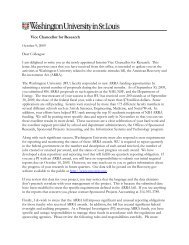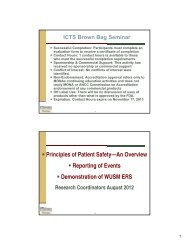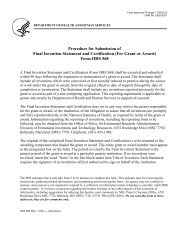A Letter from The Office of the Vice Chancellor for Research
A Letter from The Office of the Vice Chancellor for Research
A Letter from The Office of the Vice Chancellor for Research
You also want an ePaper? Increase the reach of your titles
YUMPU automatically turns print PDFs into web optimized ePapers that Google loves.
OVCR Annual ReportFiscal Year 2011Technology Management & Intellectual PropertyMethod <strong>of</strong> Treating PruritusItch, or pruritus, is an unpleasant sensation that causes <strong>the</strong> desire to scratch, associated withmany conditions such as liver disease or kidney dialysis, can find no relief <strong>for</strong> <strong>the</strong> problem.Pruritus is also a serious condition experienced by animals. <strong>The</strong> present invention providesmethods <strong>for</strong> treating pruritus by providing methods <strong>of</strong> substantially inhibiting <strong>the</strong> activation <strong>of</strong>bombesin receptors or by killing GRPR specific neurons in <strong>the</strong> spinal cord. Mitigation <strong>of</strong> itchthrough ei<strong>the</strong>r <strong>of</strong> <strong>the</strong>se mechanisms does not affect motor or sensory functions. PrimaryInvestigator: Zhou-Feng Chen, Anes<strong>the</strong>siology.Novel Genetic Risk Factor <strong>for</strong> Alzheimer’s Disease Progression<strong>Research</strong>ers at Washington University have identified a novel genetic variant that stronglycorrelates with Alzheimer’s disease progression. Dr. Alison Goate and collaborators used anestablished biomarker <strong>for</strong> <strong>the</strong> decline <strong>of</strong> AD patients (cerebrospinal fluid tau phosphorylated atthreonine 181, ptau 181 ) to find genetic variants that influence levels <strong>of</strong> ptau 181 in <strong>the</strong> cerebrospinalfluid. <strong>The</strong> study found a highly significant association between ptau 181 levels and <strong>the</strong> rs1868402SNP located within a regulatory subunit <strong>of</strong> PPP3R1 (calcineurin B), a gene previously linked toAD pathogenesis. Carriers <strong>of</strong> <strong>the</strong> rs1868402 risk allele showed a 6-fold faster rate <strong>of</strong> diseaseprogression than AD patients without <strong>the</strong> variant. Direct examination <strong>of</strong> brain samples <strong>from</strong>AD cases and controls revealed that rs1868402is in fact associated with reduced PPP3R1 mRNAlevels and increased tangle <strong>for</strong>mation, providing biological validation <strong>for</strong> <strong>the</strong> genome-wideassociation study and fur<strong>the</strong>r implicating PPP3R1 in disease pathology. As <strong>the</strong> first geneticvariant associated with rate <strong>of</strong> AD progression to be reported, its use in clinical trial design andpatient care will translate into a significant benefit to patients. Primary Investigator: AlisonGoate, PsychiatryBlood A Production and Clearance Measurements as a Diagnostic Test <strong>for</strong>Amyloidosis and Alzheimer's DiseasePrevious work <strong>from</strong> <strong>the</strong> Bateman and Holtzman labs have demonstrated clinical utility inmeasuring <strong>the</strong> syn<strong>the</strong>sis and clearance rates <strong>of</strong> <strong>the</strong> amyloid-beta (Aβ) protein as a biomarker <strong>for</strong>efficacy <strong>of</strong> candidate Alzheimer’s drugs that target <strong>the</strong> protein. In a completely distinctinvention, <strong>the</strong> labs have demonstrated <strong>the</strong> ability to detect changes in Aβ in blood plasma, anassay that has utility <strong>for</strong> assessing drug candidates as well as diagnostic applications. PrimaryInvestigator: Randy Bateman, Neurology, and Dave Holtzman, NeurologyNovel Antithrombin Nanoceutical <strong>for</strong> Preventing Blood Clots<strong>The</strong> current invention comprises a first-in-class nanoparticulate antithrombotic that features apotent dual antithrombin/antiplatelet compound linked to a nanoparticle to function as a singleunit or drug. Advantages <strong>of</strong> this novel agent include (1) prolonged activity <strong>of</strong> drug at <strong>the</strong>nanoparticle surface and only at <strong>the</strong> site <strong>of</strong> active clotting, (2) potential <strong>for</strong> image-baseddetection and tracking <strong>of</strong> <strong>the</strong> agent and <strong>the</strong> acute thrombotic process, (3) <strong>the</strong> elimination <strong>of</strong>harmful side effects after systemic delivery through <strong>the</strong> use <strong>of</strong> smaller drug amounts featuringsite-specific thrombin targeting and action, (4) well defined pharmacokinetics that are driven by<strong>the</strong> nanoparticle itself and are independent <strong>of</strong> a subject’s genetics, and (5) <strong>the</strong> ability to multiplex anyo<strong>the</strong>r anticoagulant that is already on <strong>the</strong> market or in development <strong>for</strong> combination44
















